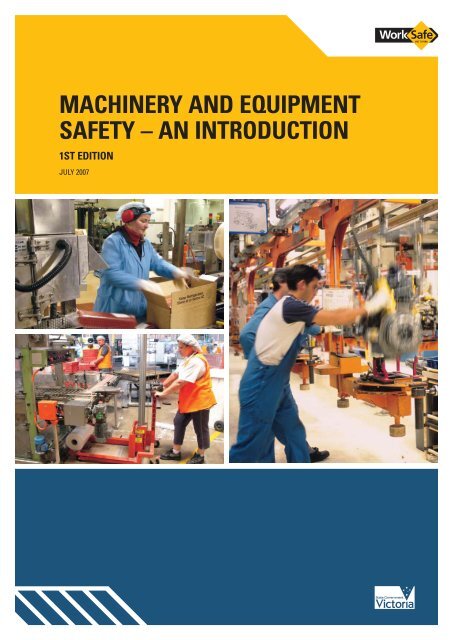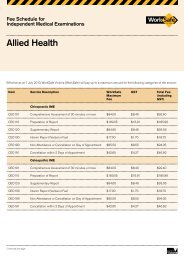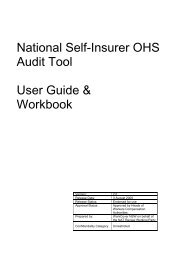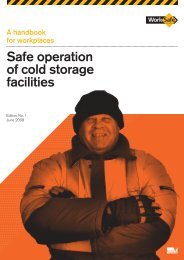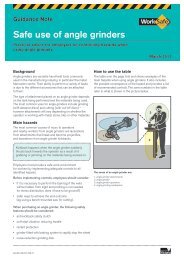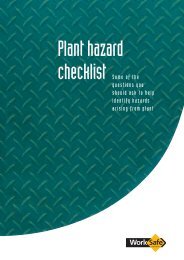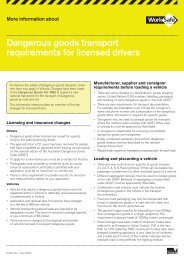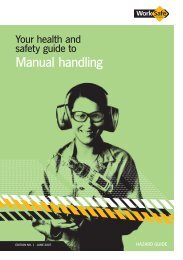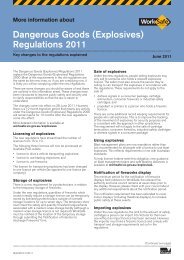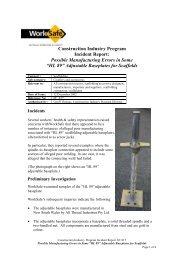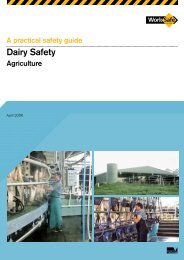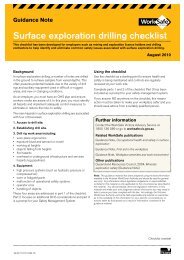Machinery and Equipment Safety - An Introduction - WorkSafe Victoria
Machinery and Equipment Safety - An Introduction - WorkSafe Victoria
Machinery and Equipment Safety - An Introduction - WorkSafe Victoria
You also want an ePaper? Increase the reach of your titles
YUMPU automatically turns print PDFs into web optimized ePapers that Google loves.
MACHINERY AND EQUIPMENT<br />
SAFETY – AN INTRODUCTION<br />
1ST EDITION<br />
JULY 2007
CONTENTS<br />
<strong>Introduction</strong> . . . . . . . . . . . . . . . . . . . . . . . . . . . . . . . . . . . 1<br />
1. Key principles of machinery <strong>and</strong><br />
equipment safety . . . . . . . . . . . . . . . . . . . . . . . . . . . . 2<br />
1.1 Mechanical hazards . . . . . . . . . . . . . . . . . . . . . . 3<br />
1.2 Non-mechanical hazards . . . . . . . . . . . . . . . . . . 4<br />
1.3 Access hazards . . . . . . . . . . . . . . . . . . . . . . . . . . 5<br />
2. Risk control of machinery <strong>and</strong><br />
equipment hazards . . . . . . . . . . . . . . . . . . . . . . . . . . 7<br />
2.1 Risk control of machinery <strong>and</strong> equipment<br />
hazards (general) . . . . . . . . . . . . . . . . . . . . . . . . 8<br />
2.2 Risk control of mechanical hazards . . . . . . . . . . 9<br />
2.3 Risk control of non-mechanical hazards . . . . . 13<br />
2.4 Risk control of access hazards . . . . . . . . . . . . . 14<br />
3. Purchasing machinery <strong>and</strong> equipment list . . . . . . 18<br />
4. Information <strong>and</strong> guidance: Where to get<br />
more information <strong>and</strong> assistance . . . . . . . . . . . . . 20<br />
The information presented in <strong>Machinery</strong> <strong>and</strong> <strong>Equipment</strong> <strong>Safety</strong> – <strong>An</strong> <strong>Introduction</strong> is intended for general use only. It should not be viewed<br />
as a definitive guide to the law, <strong>and</strong> should be read in conjunction with the Occupational Health <strong>and</strong> <strong>Safety</strong> Act 2004.<br />
Whilst every effort has been made to ensure the accuracy <strong>and</strong> completeness of the <strong>Machinery</strong> <strong>and</strong> <strong>Equipment</strong> <strong>Safety</strong> – <strong>An</strong> <strong>Introduction</strong>, the advice<br />
contained herein may not apply in every circumstance. Accordingly, <strong>WorkSafe</strong> <strong>Victoria</strong> cannot be held responsible, <strong>and</strong> extends no warranties as to:<br />
• the suitability of the information for any particular purpose;<br />
• actions taken by third parties as a result of information contained in <strong>Machinery</strong> <strong>and</strong> <strong>Equipment</strong> <strong>Safety</strong> – <strong>An</strong> <strong>Introduction</strong>.<br />
The information contained in this publication is protected by copyright. <strong>WorkSafe</strong> <strong>Victoria</strong> hereby grants a non-exclusive licence in this publication<br />
to the recipient of this publication on the condition that it is not disseminated for profit. <strong>WorkSafe</strong> <strong>Victoria</strong> encourages the free transfer, copying<br />
<strong>and</strong> printing of the information in this publication if such activities support the purposes <strong>and</strong> intent for which the publication was developed.
INTRODUCTION<br />
<strong>Machinery</strong> <strong>and</strong> <strong>Equipment</strong> <strong>Safety</strong>: <strong>An</strong> <strong>Introduction</strong> is provided in accordance with<br />
section 7(1)(f) of the Occupational Health <strong>and</strong> <strong>Safety</strong> Act 2004 (OHS Act) to assist<br />
employers <strong>and</strong> employees comply with their duties <strong>and</strong> obligations under this Act<br />
<strong>and</strong> the OHS Regulations 2007.<br />
This guide is an introduction to managing the risks associated with use of<br />
machinery <strong>and</strong> equipment in the workplace.<br />
Employers can use this guide to:<br />
• identify machinery <strong>and</strong> equipment hazards in the workplace<br />
• eliminate or reduce the risk of those hazards causing harm.<br />
The guide will also be useful to anyone else who is interested in machinery <strong>and</strong><br />
equipment safety, such as employees <strong>and</strong> Health <strong>and</strong> <strong>Safety</strong> Representatives (HSR).<br />
<strong>WorkSafe</strong> also has additional guidance supporting all topics introduced in this<br />
document. To find out more or to seek further technical information with regard<br />
to your machinery <strong>and</strong> equipment, refer to Section 4 of this document.<br />
CONSULTING EMPLOYEES AND HEALTH AND SAFETY<br />
REPRESENTATIVES<br />
Consultative processes allow people to provide input <strong>and</strong> raise potential safety<br />
concerns about the work they undertake. Although hazards associated with<br />
machinery <strong>and</strong> equipment are often easily identified, the ways in which<br />
people can gain access to, or may be exposed to, hazards require a detailed<br />
underst<strong>and</strong>ing of how they do their job.<br />
To ensure consultation occurs in workplaces, Section 35 of the Occupational<br />
Health <strong>and</strong> <strong>Safety</strong> Act 2004 directs employers to engage <strong>and</strong> consult with all<br />
people affected by changes in the workplace that may impact on their health<br />
<strong>and</strong> safety.<br />
WORKSAFE VICTORIA / MACHINERY AND EQUIPMENT SAFETY – AN INTRODUCTION 1
1<br />
KEY PRINCIPLES OF<br />
MACHINERY AND<br />
EQUIPMENT SAFETY<br />
RISKS ASSOCIATED WITH:<br />
1.1 Mechanical hazards<br />
that cannot be eliminated must be<br />
controlled to prevent harm.<br />
1.2 Non-mechanical hazards<br />
that cannot be eliminated must be<br />
controlled to prevent harmful exposure.<br />
1.3 Access hazards<br />
that cannot be eliminated must be<br />
controlled to provide safe access<br />
(for operation, maintenance, repair,<br />
installation, service, cleaning or<br />
decommissioning).<br />
2 WORKSAFE VICTORIA / MACHINERY AND EQUIPMENT SAFETY – AN INTRODUCTION
KEY PRINCIPLES OF MACHINERY<br />
AND EQUIPMENT SAFETY<br />
1.1 MECHANICAL HAZARDS<br />
Machines have moving parts. The action of moving parts may have sufficient force<br />
in motion to cause injury to people.<br />
Robotic arms can reach over their base, move<br />
with remarkable speed <strong>and</strong> high force, <strong>and</strong><br />
can cause injury if controls to separate people<br />
from moving plant are not implemented.<br />
When reviewing machinery <strong>and</strong> equipment for possible mechanical hazards,<br />
consider:<br />
• machinery <strong>and</strong> equipment with moving parts that can be reached by people<br />
• machinery <strong>and</strong> equipment that can eject objects (parts, components, products<br />
or waste items) that may strike a person with sufficient force to cause harm<br />
• machinery <strong>and</strong> equipment with moving parts that can reach people such as<br />
booms or mechanical appendages (arms)<br />
• mobile machinery <strong>and</strong> equipment, such as forklifts, pallet jacks, earth moving<br />
equipment, operated in areas where people may gain access.<br />
Common mechanical hazards <strong>and</strong> associated risks for machinery <strong>and</strong> equipment<br />
are shown below.<br />
HAZARD<br />
RISK<br />
Rotating shafts, pullies, sprockets <strong>and</strong> gears<br />
Entanglement<br />
Hard surfaces moving together<br />
Crushing<br />
Scissor or shear action<br />
Severing<br />
Mobile plant operated in areas where people<br />
work may cause injury through collision. Traffic<br />
control <strong>and</strong> segregation are forms of control.<br />
Sharp edge – moving or stationary<br />
Cable or hose connections<br />
Cutting or puncturing<br />
Slips, trips <strong>and</strong> falls (e.g. oil leaks)<br />
WORKSAFE VICTORIA / MACHINERY AND EQUIPMENT SAFETY – AN INTRODUCTION 3
KEY PRINCIPLES OF MACHINERY<br />
AND EQUIPMENT SAFETY<br />
1.2 NON-MECHANICAL HAZARDS<br />
Non-mechanical hazards associated with machinery <strong>and</strong> equipment can include<br />
harmful emissions, contained fluids or gas under pressure, chemicals <strong>and</strong> chemical<br />
by-products, electricity <strong>and</strong> noise, all of which can cause serious injury if not<br />
adequately controlled. In some cases, people exposed to these hazards may<br />
not show signs of injury or illness for years. Where people are at risk of injury<br />
due to harmful emissions from machinery <strong>and</strong> equipment, the emissions should<br />
be controlled at their source.<br />
When reviewing machinery <strong>and</strong> equipment for possible non-mechanical<br />
hazards, consider how machines <strong>and</strong> equipment can affect the area<br />
(environment) around them.<br />
Common non-mechanical hazards are shown below.<br />
Woodworking dust generated by a buzzer is<br />
removed via forced extraction <strong>and</strong> ventilation.<br />
NON-MECHANICAL HAZARDS<br />
Dust<br />
Mist (vapours or fumes)<br />
Explosive or flammable atmospheres<br />
Noise<br />
Heat (radiated or conducted)<br />
Ignition sources (flame or spark)<br />
High intensity light (laser, ultra-violet)<br />
Molten materials<br />
Heavy metals (lead, cadmium, mercury)<br />
Chemicals<br />
Steam<br />
Pressurised fluids <strong>and</strong> gases<br />
Ionising radiation (x-rays, microwaves)<br />
Electrical<br />
Welding fumes are extracted via flexible,<br />
locatable forced extraction <strong>and</strong> ventilation system.<br />
4 WORKSAFE VICTORIA / MACHINERY AND EQUIPMENT SAFETY – AN INTRODUCTION
KEY PRINCIPLES OF MACHINERY<br />
AND EQUIPMENT SAFETY<br />
1.3 ACCESS HAZARDS<br />
People must be provided with safe access that is suitable for the work they<br />
perform in, on <strong>and</strong> around machinery <strong>and</strong> equipment. A stable work platform<br />
suited to the nature of the work that allows for good posture relative to the work<br />
performed, sure footing, safe environment <strong>and</strong> fall prevention (if a fall may occur)<br />
is a basic requirement.<br />
As an example, cooling towers on building roofs may have poor access, yet must<br />
be attended by a service person at predictable times for water treatment, chemical<br />
dosing or monitoring of automated dosing equipment. People performing these<br />
tasks must be provided with the means to get themselves <strong>and</strong> any equipment<br />
they require onto the roof with no risk or minimal risk of fall or injury.<br />
Permanently fixed gantries, ladders <strong>and</strong><br />
walkways are incorporated into this machinery<br />
<strong>and</strong> equipment to reduce the risk of a fall from<br />
height occurring during operation<br />
<strong>and</strong> maintenance.<br />
When thinking about safe access to machinery <strong>and</strong> equipment, think about<br />
how, who, when <strong>and</strong> what:<br />
• who will be working on or around the machinery <strong>and</strong> equipment<br />
• people required to work in enclosed areas where the atmosphere could<br />
be harmful, such as pits, tanks or storage vessels<br />
• what equipment or materials need to be carried to undertake the task<br />
• where <strong>and</strong> when is access required for operation, maintenance <strong>and</strong> cleaning<br />
• how will people gain safe access (walkway, gantry, elevated work platform<br />
or ladder)<br />
• what work will be carried out during access<br />
• will people be near or exposed to an unidentified mechanical or<br />
non-mechanical hazard at the time of access<br />
• has consultation occurred with employees or contractors regarding how they<br />
intend to gain access, <strong>and</strong> what equipment <strong>and</strong> work platform or structure is<br />
best suited for the intended task<br />
Access<br />
Access needs can be predicted <strong>and</strong> access planning must occur in advance.<br />
People need access to machinery <strong>and</strong> equipment in the workplace (either continually<br />
or occasionally) for tasks such as operation, maintenance, repair, installation, service<br />
or cleaning. These tasks are examples of access that can be predicted.<br />
Access may vary during each stage of machinery <strong>and</strong> equipment life cycle.<br />
For example:<br />
• installation or removal<br />
– complete access from every area may be required, <strong>and</strong> involve<br />
disconnection or connection of services such water, air, pipes,<br />
installation of electrical cable to switch board, etc.<br />
• operation<br />
– access for set-up, operation <strong>and</strong> adjustment.<br />
• maintenance, repair, cleaning, alteration or adaptation<br />
– access to remote areas may be required.<br />
WORKSAFE VICTORIA / MACHINERY AND EQUIPMENT SAFETY – AN INTRODUCTION 5
KEY PRINCIPLES OF MACHINERY<br />
AND EQUIPMENT SAFETY<br />
EXAMPLES OF COMMON HAZARDS BY TYPE OF WORKPLACE ACTIVITY<br />
PEOPLE WHO INSTALL OR DISMANTLE MACHINES AND EQUIPMENT COULD:<br />
• work in isolation<br />
• work on machines <strong>and</strong> equipment at height or over machinery or equipment to connect services (such as electricity, air or water)<br />
• work in low light or with bright directional light<br />
• access machinery <strong>and</strong> equipment from the top, sides or underneath<br />
• work with/near cranes, forklift or rigging to lift machinery <strong>and</strong> equipment<br />
• work in confined spaces<br />
• use power tools, welders, extension leads, which present electrical hazards if damaged or wet.<br />
PEOPLE OPERATING MACHINES AND EQUIPMENT COULD:<br />
• be required to place their h<strong>and</strong>s close to the mechanism of the machinery or equipment that does the work, <strong>and</strong> may be injured<br />
if caught or trapped by moving parts<br />
• be exposed to constant harmful noise, radiated energy or fumes being emitted from the machinery <strong>and</strong> equipment they are operating<br />
or are close to<br />
• inadvertently bump or knock poorly placed control levers or buttons<br />
• be required to make adjustments to the mechanism of machinery <strong>and</strong> equipment while the machine is in motion<br />
• be required to clear away scrap<br />
• make minor adjustments or reach into the moving mechanism of the machine they are operating.<br />
PEOPLE PROVIDING MAINTENANCE OR REPAIR SERVICES COULD:<br />
• work alone<br />
• work on machines <strong>and</strong> equipment at height, or over machines <strong>and</strong> equipment to connect services (such as electricity, air or water)<br />
• access machines <strong>and</strong> equipment from the rear or sides<br />
• need to enter confined spaces of larger machinery <strong>and</strong> equipment<br />
• be trapped by mechanism of the machinery <strong>and</strong> equipment through poor isolation of energy sources or stored energy, such as<br />
spring-loaded or counter-balance mechanisms, compressed air or fluids, or parts held in position by hydraulics or pneumatic (air) rams<br />
• move heavy parts when changing the set-up of machinery <strong>and</strong> equipment, or repairing failed parts such as electric motors<br />
or gear box assemblies<br />
• disable or remove normal safety systems to access machines <strong>and</strong> equipment mechanism.<br />
PEOPLE PROVIDING CLEANING SERVICES COULD:<br />
• work alone<br />
• access machines <strong>and</strong> equipment from the rear or sides or in unexpected ways<br />
• climb on machines <strong>and</strong> equipment<br />
• enter confined spaces of larger machines <strong>and</strong> equipment<br />
• become trapped by mechanism of the machinery <strong>and</strong> equipment through poor isolation of energy sources or stored energy, such as<br />
spring-loaded or counter-balance mechanisms, compressed air or fluids, or parts held in position by hydraulics or pneumatic (air) rams<br />
• work with chemicals<br />
• operate electrical equipment in wet areas.<br />
6 WORKSAFE VICTORIA / MACHINERY AND EQUIPMENT SAFETY – AN INTRODUCTION
2<br />
RISK CONTROL OF<br />
MACHINERY AND<br />
EQUIPMENT HAZARDS<br />
2.1 Risk control of machinery <strong>and</strong><br />
equipment hazards (general)<br />
2.2 Risk control of mechanical hazards<br />
2.3 Risk control of non-mechanical<br />
hazards<br />
2.4 Risk control of access hazards<br />
WORKSAFE VICTORIA / MACHINERY AND EQUIPMENT SAFETY – AN INTRODUCTION 7
RISK CONTROL OF MACHINERY<br />
AND EQUIPMENT HAZARDS<br />
2.1 RISK CONTROL OF MACHINERY AND EQUIPMENT<br />
HAZARDS (GENERAL)<br />
Where exposure to machinery <strong>and</strong> equipment hazards cannot be eliminated or<br />
substituted for machinery <strong>and</strong> equipment of improved design, risk control(s) must<br />
be applied to the hazards that prevents or reduces the risk (chance) of injury or<br />
harm. Health <strong>and</strong> safety laws require the highest order control be applied so far<br />
as is reasonably practicable.<br />
Centre lathe: The exposed rotating chuck<br />
of a centre lathe can eject parts or tools with<br />
great force, cutting fluid fumes are difficult<br />
to contain <strong>and</strong> the machinery requires<br />
manual set-up.<br />
CNC Lathe: Substituting a centre lathe with<br />
a CNC lathe (Computer Numeric Control) is an<br />
example of improved risk control of machinery<br />
<strong>and</strong> equipment through improvement in design.<br />
Higher order machinery <strong>and</strong> equipment risk controls are preventative by nature,<br />
are effective <strong>and</strong> durable for the environment it is used in, <strong>and</strong> deal directly with<br />
the hazard at its source.<br />
Lower order machinery <strong>and</strong> equipment risk controls, such as personal protective<br />
equipment (PPE), can prevent injuries, but are generally not as effective as higher<br />
order controls, as they rely more on employee behaviour, maintenance programs<br />
<strong>and</strong> supervision.<br />
Administrative controls use systems of work to reduce risk by providing a<br />
framework of expected behaviours. Examples are rotation of staff to reduce<br />
exposure to a hazard, or a documented safe system of work, such as ‘lock<br />
out-tag out’. These types of controls rely on extensive instruction, information,<br />
training <strong>and</strong> supervision. In terms of time <strong>and</strong> ongoing administration by managers<br />
<strong>and</strong> employers to ensure the desired behaviour occurs, administrative controls can<br />
be the most expensive <strong>and</strong> least effective form of hazard control.<br />
Note: The use of PPE <strong>and</strong> administrative controls are low or last order<br />
controls used to deal with any residual risk associated with the hazard.<br />
As such, these last resort controls can be used in support of higher order<br />
controls that deal with a hazard at its source <strong>and</strong> should not be considered<br />
as the sole means of control. These types of risk controls require constant<br />
monitoring <strong>and</strong> reinforcement.<br />
Effective machinery <strong>and</strong> equipment risk controls reflect some or all of the<br />
following characteristics:<br />
• the hazard is controlled at its source<br />
• contact or access to the hazard is prevented<br />
• sturdy construction (correct materials with few points of potential failure)<br />
• fail-safe (failure of the control system to be effective will result in machinery<br />
shut-down)<br />
• tamper-proof design (as difficult as possible to bypass)<br />
• presents minimum impediment to machinery <strong>and</strong> equipment operator<br />
• easy to inspect <strong>and</strong> maintain<br />
• does not introduce further hazards through action of the risk control.<br />
8 WORKSAFE VICTORIA / MACHINERY AND EQUIPMENT SAFETY – AN INTRODUCTION
RISK CONTROL OF MACHINERY<br />
AND EQUIPMENT HAZARDS<br />
2.2 RISK CONTROL OF MECHANICAL HAZARDS<br />
Separation is a simple <strong>and</strong> effective machinery <strong>and</strong> equipment risk control.<br />
Separation may be achieved by distance, barrier or time.<br />
Fences, barriers, guards <strong>and</strong> interlocked gates<br />
separate people from the hazardous action<br />
of machinery <strong>and</strong> equipment.<br />
• Distance separation means a person cannot reach the hazard due to distance.<br />
• Barrier separation means an effective barrier or guard denies access <strong>and</strong><br />
controls ejection of parts, products or waste.<br />
• Time separation means at the time of access, the machinery or equipment<br />
is disabled.<br />
Examples include:<br />
• physical barriers <strong>and</strong> guards such as fences, screens or fixed panels of<br />
various materials<br />
• various forms of guarding <strong>and</strong> interlocking (as described in Australian St<strong>and</strong>ard<br />
AS 4024, part 1601 <strong>and</strong> part 1602, <strong>Safety</strong> of <strong>Machinery</strong>)<br />
• making the hazard inaccessible by reach (where the distance between a person<br />
<strong>and</strong> the hazard forms an effective barrier).<br />
Note: When considering the suitability of distance guarding, also consider the safe<br />
access requirements of maintenance people who gain access by ladder, scaffold<br />
or elevated work platform.<br />
Guarding<br />
A guard can perform several functions: it can deny bodily access, contain ejected<br />
parts, tools, off-cuts or swath, prevent emissions escaping or form part of a safe<br />
working platform.<br />
<strong>An</strong> old style power press incorporating a<br />
manual interlock <strong>and</strong> adjustable guarding.<br />
If the guard slides up, a connected metal<br />
bar separates the clutch mechanism <strong>and</strong><br />
the press will not activate.<br />
The guard can be adjusted to provide an<br />
opening by releasing retaining bolts on the<br />
guard face to allow individual panels to move.<br />
Adjustment must be performed by an<br />
experienced person to ensure the resulting<br />
opening only provides room necessary to<br />
incorporate the material being fed in <strong>and</strong><br />
prevents h<strong>and</strong>s or fingers intruding into the<br />
danger area.<br />
Guarding is commonly used with machinery <strong>and</strong> equipment to prevent access to:<br />
• rotating end drums of belt conveyors<br />
• moving augers of auger conveyors<br />
• rotating shafts<br />
• moving parts that do not require regular adjustment<br />
• machine transmissions, such as pulley <strong>and</strong> belt drives,<br />
chain drives, exposed drive gears<br />
• any dangerous moving parts, machines or equipment.<br />
Where access is not anticipated, a fixed guard can be permanently applied by<br />
bonding agent, welding or secured with one-way screws. If access is generally<br />
not required, a permanently fixed barrier is the preferred option.<br />
Where access to the hazard is infrequent, the installation of a fitted guard that<br />
can be removed by use of a tool may be an acceptable control, where the tool<br />
to remove the barrier or guard is not normally available to the operator.<br />
Adjustable guarding incorporates movable sections or panels of the guard <strong>and</strong><br />
allows for material or parts to be fed into the guarded area while still preventing<br />
bodily contact.<br />
WORKSAFE VICTORIA / MACHINERY AND EQUIPMENT SAFETY – AN INTRODUCTION 9
RISK CONTROL OF MACHINERY<br />
AND EQUIPMENT HAZARDS<br />
Tunnel guards provide a tunnel, aperture or chute in which material can be<br />
inserted into the machinery <strong>and</strong> equipment, but due to the restrictive design<br />
<strong>and</strong> depth of the opening, fingers, h<strong>and</strong>s, arms or the entire person is prevented<br />
from intruding into the danger area.<br />
Where frequent cleaning is required, the guard may be constructed of mesh that<br />
prevents intrusion of body parts but allows for hosing. Food production workplaces<br />
that use conveyors in areas where hygiene or food safety is an integral part of the<br />
operation use fixed mesh guarding of conveyor end rollers.<br />
Interlock guarding occurs when the act of moving the guard (opening, sliding<br />
or removing) to allow access stops the action of the hazardous mechanism.<br />
The narrow throat of the mincer prevents a<br />
person’s h<strong>and</strong> from accessing the hazard.<br />
<strong>An</strong> old style press refurbished with an<br />
interlocked safety cage <strong>and</strong> gate.<br />
The control mechanism uses a combination of<br />
pneumatics <strong>and</strong> electrical interlocking to ensure<br />
the danger area of the press cannot be accessed<br />
unless the press downstroke action is disabled.<br />
Improved design <strong>and</strong> technology can be fitted to<br />
older machinery <strong>and</strong> equipment to meet current<br />
st<strong>and</strong>ards <strong>and</strong> reflect the latest knowledge<br />
regarding ways to control hazards <strong>and</strong> risks<br />
in the workplace.<br />
Interlock guarding works by:<br />
• mechanically disconnecting the drive mechanism (applies a brake or disengages<br />
a clutch or geared mechanism)<br />
• isolating the power source of the drive mechanism (stops the motor)<br />
• a combination of mechanical <strong>and</strong> power disconnection.<br />
Interlock guarding is generally achieved via mechanical or electrical means, but<br />
may also include hydraulic or pneumatic control systems.<br />
The energy stored in moving parts (momentum) can cause the mechanism of the<br />
machine or equipment to run on for some time after the source of driving energy<br />
has been removed.<br />
For access panels or doors supporting an interlocking device that allows access<br />
to mechanical parts that move for periods after the energy source is removed,<br />
a separate mechanism to delay release of the retaining or locking mechanism<br />
may be incorporated.<br />
Captive key systems rely upon a single key that is shared between the<br />
control panel (‘on’ switch) <strong>and</strong> the access gate lock of the physical barrier<br />
to the danger area. Removal of the key from the control panel can only occur<br />
when the switch is in the off position, <strong>and</strong> the gate will only release the key<br />
when in the locked position.<br />
Captive key systems do not provide full isolation of the power source, but may<br />
provide limited temporary access under controlled conditions.<br />
Effective supervision, instruction <strong>and</strong> training are required as administrative<br />
controls to ensure that only one key is available for the system, <strong>and</strong> the key<br />
is not removed from the access gate or guard by a second operator while<br />
a person is exposed to the danger area of the plant. Operations such as<br />
maintenance, repair, installation service or cleaning may require all energy<br />
sources to be isolated <strong>and</strong> locked out to avoid accidental start-up.<br />
Captive key systems: The key cannot be<br />
removed unless it is in the off position. The<br />
same key is used to unlock the access gate.<br />
Only one key per system is retained by the<br />
locking mechanism.<br />
10 WORKSAFE VICTORIA / MACHINERY AND EQUIPMENT SAFETY – AN INTRODUCTION
RISK CONTROL OF MACHINERY<br />
AND EQUIPMENT HAZARDS<br />
Other mechanical hazard risk control options<br />
A two-h<strong>and</strong>ed control option may be suitable<br />
to ensure that a machine cannot operate until<br />
both h<strong>and</strong>s of the operator are clear of the<br />
hazard area.<br />
A light curtain used to disable the hazardous<br />
mechanism of a machine must resist failure<br />
<strong>and</strong> fault.<br />
Simultaneous two-h<strong>and</strong>ed operation<br />
Where a machine has only one operator, the use of simultaneous two-h<strong>and</strong>ed<br />
operation buttons can serve as a risk control. This ensures that operation of the<br />
hazardous mechanism cannot occur until both h<strong>and</strong>s are clear of the danger area.<br />
The two buttons must be pushed at the same time <strong>and</strong> are located at a distance<br />
from each other that prevents simultaneous operation by one h<strong>and</strong>.<br />
The operation should be designed so that if either or both of the buttons are<br />
released, the hazardous action of the machine or equipment cannot be reached,<br />
or if it can be reached, the mechanism returns to a safe state.<br />
Presence sensing systems<br />
If physical guards are not reasonably practicable, then a presence sensing system<br />
can be used as a control to reduce risk. Presence sensing systems can be used<br />
where people enter areas shared by moving production equipment.<br />
Presence sensing systems are capable of providing a high degree of flexibility<br />
with regard to access.<br />
Presence sensing systems detect when a person is in the identified danger area,<br />
<strong>and</strong> stops or reduces the power or speed of the mechanism at the time of entry<br />
to provide for safe access.<br />
Presence sensing systems can rely on foot pressure pads, infra-red sensing, light<br />
beams or laser scanning. The most appropriate type of sensing device will depend<br />
on the operating environment <strong>and</strong> access requirements.<br />
Australian St<strong>and</strong>ard AS 4024.2 provides guidance on design specification, ratings<br />
on integrity <strong>and</strong> reaction times. Manufacturers’ specifications for installation <strong>and</strong><br />
maintenance must also be observed.<br />
Specialist assistance may be required by experienced professionals to ensure<br />
correct selection <strong>and</strong> installation of presence sensing systems. Companies<br />
who manufacture or supply these systems also provide technical support<br />
<strong>and</strong> installation assistance.<br />
WORKSAFE VICTORIA / MACHINERY AND EQUIPMENT SAFETY – AN INTRODUCTION 11
RISK CONTROL OF MACHINERY<br />
AND EQUIPMENT HAZARDS<br />
Critical safety systems<br />
A safety control system responsible for ensuring the safety of a person when<br />
approaching or accessing a hazard is called a critical safety system.<br />
Failure of the critical safety system will leave a person exposed to the hazard,<br />
<strong>and</strong> in danger.<br />
Critical safety systems may include barriers or guards fitted to prevent access, or<br />
integrated complex interlocking <strong>and</strong> presence sensing systems. Failure to replace<br />
guards, damaged perimeter fences that allow access <strong>and</strong> bypassed or disabled<br />
interlocking systems are examples of critical safety systems failures that require<br />
immediate attention to ensure the safety of people.<br />
Components relied on to protect people from<br />
harm are designed <strong>and</strong> built to a high st<strong>and</strong>ard,<br />
<strong>and</strong> display compliance ratings relative to their<br />
reliability. They must also be correctly installed<br />
to ensure their effective operation.<br />
High integrity/fail-safe control<br />
All safety control systems should be designed <strong>and</strong> built to prevent failure or, in<br />
the event of failure, de-activate the operation of the machinery <strong>and</strong> equipment.<br />
The extent to which a safety control system should tolerate faults is a function<br />
of risk (likelihood <strong>and</strong> consequence), <strong>and</strong> is described fully in Australian St<strong>and</strong>ard<br />
AS 4024.1501 <strong>Safety</strong> Related Parts of Control Systems, which explains the<br />
categories of control required as a function of increasing risk.<br />
Many different types of machinery <strong>and</strong> equipment use high integrity safety<br />
systems that disable a mechanism at the time of access. Some examples include:<br />
• brake press<br />
• power press<br />
• robotic machine (automated machines)<br />
• injection moulders<br />
• powered guillotines<br />
• programmable lathe <strong>and</strong> milling equipment<br />
• industrial mixers<br />
• mincing equipment<br />
• plasma cutting tables<br />
• laser cutting tables.<br />
Redundant <strong>and</strong> self-monitoring fault detection systems<br />
Redundant or dual systems (doubling up) <strong>and</strong> self-monitoring fault detection<br />
systems are also effective methods to prevent failure of critical safety systems.<br />
Selection <strong>and</strong> installation of these types of complex interactive control measures<br />
may require expert or specialist assistance.<br />
The Australian St<strong>and</strong>ards provide information on plant safety systems <strong>and</strong> reflect<br />
current state of knowledge <strong>and</strong> best practice. The AS 4024 <strong>Safety</strong> of <strong>Machinery</strong><br />
series of publications provides specific information for commonly used machine<br />
types in industry such as woodworking or metal working machinery.<br />
12 WORKSAFE VICTORIA / MACHINERY AND EQUIPMENT SAFETY – AN INTRODUCTION
RISK CONTROL OF MACHINERY<br />
AND EQUIPMENT HAZARDS<br />
2.3 RISK CONTROL OF NON-MECHANICAL HAZARDS<br />
The first step in selecting suitable <strong>and</strong> effective controls for non-mechanical<br />
hazards is to underst<strong>and</strong> the nature of emissions that can be released by<br />
machinery <strong>and</strong> equipment in the workplace, where those emissions collect<br />
<strong>and</strong> the way they may cause harm.<br />
• Separating people from non-mechanical hazards is necessary where the<br />
emission cannot be controlled at the source through elimination or substitution.<br />
Hazardous machinery <strong>and</strong> equipment emission controls rely largely on isolation<br />
of people from the hazardous emission.<br />
Hoods, lids, covers or impervious guards (solid barriers that prevent escape<br />
of the emission) can serve to contain a number of different types of emissions<br />
within machinery or equipment.<br />
For potentially harmful substance exposures from machinery <strong>and</strong> equipment,<br />
such as mist, fumes, vapour or dust, <strong>and</strong> where it is not reasonably practicable<br />
to control the emission at its source, ventilation <strong>and</strong> extraction systems are<br />
used to remove the hazardous atmosphere from the work environment.<br />
• For noise, guarding may also serve to mute noise emissions through application<br />
of sound absorbing materials. Other emissions such as lasers, ultra-violet light,<br />
bright light or welding flash can also be safely screened to prevent potential<br />
harmful exposure.<br />
• Oil leaks from machinery or equipment may present a serious slip hazard.<br />
By preventing oil leaks through routine maintenance, or containing leaking<br />
oil with a drip tray or through spill containment strategies, the risk the hazard<br />
presents is controlled.<br />
Personal protective equipment<br />
Where it is not reasonably practicable for emissions to be controlled at their<br />
source or removed or reduced through effective ventilation, extraction or diversion,<br />
the use of personal protective equipment (PPE) as a final measure must be<br />
considered to ensure safety.<br />
PPE is a lower order control <strong>and</strong> can only be used where higher order controls<br />
are not reasonably practicable or are not totally effective.<br />
Selection <strong>and</strong> use of PPE requires careful consideration, as there are many<br />
different types that reduce the risk of injury of contact or exposure to a hazard.<br />
Incorrect use of PPE or purchasing inappropriate PPE can contribute to serious<br />
workplace incidents.<br />
PPE that is uncomfortable, restrictive or heavy may create secondary hazards, <strong>and</strong>,<br />
as a result, constant supervision may be necessary to ensure it is used effectively.<br />
Ear muffs.<br />
Gloves.<br />
Particle half face respirator.<br />
Welding mask.<br />
<strong>Safety</strong> glasses.<br />
WORKSAFE VICTORIA / MACHINERY AND EQUIPMENT SAFETY – AN INTRODUCTION 13
RISK CONTROL OF MACHINERY<br />
AND EQUIPMENT HAZARDS<br />
2.4 RISK CONTROL OF ACCESS HAZARDS<br />
Confined space<br />
Larger machinery <strong>and</strong> equipment may contain internal areas where a hazardous<br />
atmosphere may occur by design or as a result of the work being done.<br />
A confined space may exist where people require access to a mostly closed area<br />
that presents difficult or restricted path of access, where oxygen levels may be<br />
depleted or displaced, or where harmful levels of contaminate, such as gas, vapour<br />
or dust, exist.<br />
Training in confined space entry, including issue of entry permits <strong>and</strong> continuous<br />
monitoring <strong>and</strong> supervision, is m<strong>and</strong>atory. There are legal requirements that must<br />
be observed prior to allowing people to enter a confined space.<br />
Fixed access platform.<br />
Mobile work platform with fall arrest harness.<br />
Temporary mobile platform.<br />
Working at height<br />
Providing people with a suitable work platform for the task being undertaken<br />
reduces the risk of injury from falling from machinery <strong>and</strong> equipment.<br />
Often ‘safe access’ equipment made available during installation of machinery or<br />
equipment is removed after commissioning. Workplace managers may not have<br />
considered or recognised the need to provide similar means to gain safe access<br />
to parts of machinery <strong>and</strong> equipment at height or in awkward locations for<br />
maintenance, repair, service or cleaning activities.<br />
Safe access at height can be broken into three categories. Each category has in<br />
common the need to provide a stable, safe platform suitable for the work to be<br />
undertaken, <strong>and</strong> to be equipped to support <strong>and</strong> retain a person within the confines<br />
of the platform.<br />
1. Fixed or permanently installed access platforms:<br />
• gantries<br />
• mezzanine floors<br />
• fixed platforms<br />
• stairways.<br />
2. Mobile elevated work platforms (EWPs):<br />
• scissor lifts<br />
• knuckle booms.<br />
Note: Safe work practices must take into account the risk of trapping an<br />
operator between the EWP <strong>and</strong> a fixed structure, e.g. overhead beams,<br />
electrical cables, pipes.<br />
3. Temporary platforms:<br />
• scaffolding<br />
• ladders.<br />
Where safe working platforms are used <strong>and</strong> the risk of a fall remains, travel<br />
restraint <strong>and</strong> fall arrest harnesses can be used where a suitable point of<br />
attachment exists. Harness systems, anchor points <strong>and</strong> shock absorbing<br />
lanyards must be compatible at each point of attachment from the anchor<br />
point to the harness, with approved <strong>and</strong> rated latching devices to ensure the<br />
integrity of the system.<br />
When using fall arrest systems, specialist assistance may be necessary to<br />
select appropriate equipment, provide effective training in use <strong>and</strong> inspection,<br />
<strong>and</strong> develop an emergency retrieval plan to recover a person suspended in a fall<br />
arrest harness. People suspended by a harness for short periods of time may<br />
suffer serious health effects or may have incurred injury during the fall prior to the<br />
fall arrest device deploying. Emergency retrieval plans should allow for immediate<br />
local response in safely retrieving people to avoid fatalities.<br />
Note: OHS Regulations 2007 prescribes specific requirements that must be<br />
taken into account when determining risk controls for both confined spaces<br />
<strong>and</strong> working at heights.<br />
14 WORKSAFE VICTORIA / MACHINERY AND EQUIPMENT SAFETY – AN INTRODUCTION
RISK CONTROL OF MACHINERY<br />
AND EQUIPMENT HAZARDS<br />
Lock out–tag out: Removing <strong>and</strong> controlling energy sources during access<br />
People performing tasks such as maintenance, repair, installation, service <strong>and</strong><br />
cleaning are highly vulnerable, <strong>and</strong> have a higher risk of being killed or maimed<br />
through inadvertent operation of machinery <strong>and</strong> equipment they are working in,<br />
on or around.<br />
Accidental start-up or movement of a machine mechanism can occur if control<br />
levers or buttons are bumped or knocked, if a short circuit of the control system<br />
occurs, when hydraulic or air pressure is released, or when undoing retaining bolts.<br />
It is essential that people who work in, on or around machinery <strong>and</strong> equipment are<br />
not exposed to hazards due to accidental start-up or movement of the mechanism.<br />
(Reference: Australian St<strong>and</strong>ard AS 4024.1603 <strong>Safety</strong> of <strong>Machinery</strong>.)<br />
The following is an overview of the lock out–tag out process:<br />
• shut-down the machinery <strong>and</strong> equipment<br />
• identify all energy sources <strong>and</strong> other hazards<br />
• identify all isolation points<br />
• isolate all energy sources<br />
• de-energise all stored energies<br />
• lock out all isolation points<br />
• tag machinery controls, energy sources <strong>and</strong> other hazards<br />
• test by ‘trying’ to reactivate the plant without exposing the tester or others<br />
to risk (failure to reactivate ensures that isolation procedures are effective<br />
<strong>and</strong> all stored energies have been dissipated).<br />
Identifying energy sources<br />
All energy sources likely to activate the machinery <strong>and</strong> equipment <strong>and</strong> expose<br />
people to hazards should be identified prior to work beginning.<br />
Such energy sources include:<br />
• electricity (mains)<br />
• battery or capacitor banks<br />
• fuels<br />
• heat<br />
• steam<br />
• fluids or gases under pressure (water, air steam or hydraulic oil)<br />
• stored energy<br />
• gravity<br />
• radiation.<br />
If original designer <strong>and</strong> installer ‘as built’ diagrams of machinery <strong>and</strong> equipment<br />
installations are not available, new diagrams <strong>and</strong> photographs showing location<br />
<strong>and</strong> details of various isolation points of machinery <strong>and</strong> equipment should be<br />
developed as part of the isolation procedures. Isolation points may include<br />
switches, valves, energy lines, pipes, power sources.<br />
These diagrams <strong>and</strong> photographs can then be used, along with written<br />
procedures, for information <strong>and</strong> training.<br />
WORKSAFE VICTORIA / MACHINERY AND EQUIPMENT SAFETY – AN INTRODUCTION 15
RISK CONTROL OF MACHINERY<br />
AND EQUIPMENT HAZARDS<br />
De-energise stored energies<br />
<strong>An</strong>y or all of the following steps are necessary to guard against energy left in<br />
the machinery <strong>and</strong> equipment after it has been isolated from its energy sources:<br />
• inspect the machinery <strong>and</strong> equipment to make sure all parts have<br />
stopped moving<br />
• install ground wires<br />
• release the tension on springs or block the movement of spring-loaded parts<br />
• block or brace parts that could fall<br />
• block parts in hydraulic <strong>and</strong> pneumatic systems that could move from<br />
pressure loss<br />
• bleed the lines <strong>and</strong> leave vent valves open<br />
• drain process piping systems <strong>and</strong> close valves to prevent the flow of<br />
hazardous material<br />
• if a line must be blocked where there is no valve, use a blank flange<br />
• purge reactor tanks <strong>and</strong> process lines<br />
• dissipate extreme cold or heat, or provide protective clothing<br />
• if stored energy can accumulate, it must be monitored to ensure it stays<br />
below hazardous levels.<br />
Isolation procedures<br />
Isolation procedures in each workplace vary in detail because of differences in<br />
machinery <strong>and</strong> equipment, power sources, hazards <strong>and</strong> processes. However,<br />
if adequate interlocking is not possible, or the maintenance, repair, installation,<br />
service or cleaning requires the method of guarding or interlocking to be bypassed<br />
or removed, an isolation procedure should be implemented.<br />
Note: Activating operational stop buttons, emergency stop devices or interlock<br />
devices is not equivalent to the isolation of power sources or the release of<br />
stored energy.<br />
Lock out<br />
Isolation devices<br />
A wide range of devices is available for locking out energy sources <strong>and</strong> other<br />
hazards that could pose a risk to people working on machinery <strong>and</strong> equipment.<br />
These devices include switches with a built-in lock, <strong>and</strong> lock outs for circuit<br />
breakers, fuses <strong>and</strong> all types of valves.<br />
Also readily available are chains, safety lock out jaws (sometimes called hasps),<br />
which accommodate a number of padlocks, <strong>and</strong> sets of robust safety padlocks.<br />
Only devices that incorporate a lock or accommodate one or more padlocks are<br />
suitable lock out devices.<br />
16 WORKSAFE VICTORIA / MACHINERY AND EQUIPMENT SAFETY – AN INTRODUCTION
RISK CONTROL OF MACHINERY<br />
AND EQUIPMENT HAZARDS<br />
Tag <strong>and</strong> lock.<br />
One person – one lock<br />
If more than one person is working on the same item of machinery <strong>and</strong><br />
equipment, each person should attach their own lock to prevent the isolator<br />
being opened while their specific task is in progress.<br />
The isolation procedure should identify common lock out points to ensure<br />
energy cannot be restored while someone is still working on the machinery<br />
<strong>and</strong> equipment.<br />
If two or more people are working on machinery <strong>and</strong> equipment that is isolated<br />
through several lock out points, each person should attach a lock <strong>and</strong> tag to each<br />
lock out point.<br />
To avoid the need for multiple locks on each lock out point, a lock box may be<br />
used. Under this system, each lock out point is locked by only one lock, <strong>and</strong> the<br />
keys to the locks of the machinery’s lock out points are placed inside a box that<br />
is locked by all the individual locks of people working on the same plant.<br />
One lock – one key<br />
Each person working on the machinery <strong>and</strong> equipment should have their<br />
own lock, key <strong>and</strong> tag. There should be no duplicate key available for any lock,<br />
except a master or duplicate key for use in an emergency that is secured <strong>and</strong><br />
not readily available.<br />
During inspection, repair, maintenance, cleaning or adjustment of the machinery<br />
<strong>and</strong> equipment, the one key to each person’s lock should be held only by that<br />
person, who is responsible for both locking <strong>and</strong> unlocking the lock out device.<br />
Multiple energy sources<br />
If more than one energy source or hazard has to be locked out to enable safe<br />
shut-down of the machinery <strong>and</strong> equipment, the single key to each lock out device<br />
should be held by the same person.<br />
Multiple locks.<br />
Tag out<br />
A tag on its own is not an effective isolation device. A tag acts only as a means<br />
of providing information to others at the workplace. A lock should be used as an<br />
isolation device, <strong>and</strong> can be accompanied by a tag.<br />
Valve lock <strong>and</strong> tag.<br />
WORKSAFE VICTORIA / MACHINERY AND EQUIPMENT SAFETY – AN INTRODUCTION 17
3<br />
PURCHASING<br />
MACHINERY AND<br />
EQUIPMENT LIST<br />
The following list provides topics for consideration <strong>and</strong> consultation when purchasing<br />
machinery <strong>and</strong> equipment. It is important to also note that under Section 29 <strong>and</strong> 30 of the<br />
OHS Act, manufacturers <strong>and</strong> suppliers of plant <strong>and</strong> substances have specific duties. To find<br />
out what these duties are, please refer to Section 4, Information <strong>and</strong> guidance, in this guide.<br />
PEOPLE<br />
• who will come into contact with the machinery <strong>and</strong> equipment<br />
• what are people required to do<br />
• how will work be carried out <strong>and</strong> completed<br />
• based on the knowledge of existing machinery <strong>and</strong> equipment, what improvements should the purchaser specify when buying<br />
new machinery <strong>and</strong> equipment<br />
DOCUMENTATION AND TRAINING<br />
• what supporting documentation will accompany the new machinery <strong>and</strong> equipment<br />
• to what st<strong>and</strong>ards has the machinery <strong>and</strong> equipment been manufactured (Australian, European, Japanese, American)<br />
• what support is offered by machinery <strong>and</strong> equipment suppliers (service, training, maintenance)<br />
• what operating <strong>and</strong> maintenance information is supplied with the new machinery <strong>and</strong> equipment<br />
• is the supplied information sufficient to provide the basis of a workplace training package<br />
• if the machinery <strong>and</strong> equipment is refurbished or second-h<strong>and</strong>, how do the risk controls compare with like new machinery <strong>and</strong> equipment<br />
• have you allowed extra resources to upgrade existing risk controls to reflect current state of knowledge<br />
18 WORKSAFE VICTORIA / MACHINERY AND EQUIPMENT SAFETY – AN INTRODUCTION
PURCHASING MACHINERY<br />
AND EQUIPMENT LIST<br />
LOCATION<br />
• where is the machinery <strong>and</strong> equipment to be located, <strong>and</strong> how much space does it require<br />
• is there enough room to access your machinery <strong>and</strong> equipment for servicing, maintenance, repair or cleaning<br />
• do people walk past or work in close proximity to the proposed machinery <strong>and</strong> equipment location<br />
• is there enough light<br />
• is there sufficient ventilation<br />
OPERATION AND MAINTENANCE<br />
• will the machinery <strong>and</strong> equipment introduce more noise to the workplace<br />
• will your machinery <strong>and</strong> equipment perform a task other than what it was designed for<br />
• what types of emissions does the machinery <strong>and</strong> equipment produce when operated or cleaned, such as noise, fumes, light <strong>and</strong> heat<br />
• what are the expected hours of machinery <strong>and</strong> equipment operation<br />
• how will material arrive, <strong>and</strong> how is product going to be removed after the process is complete<br />
• are there environmental factors, such as hazardous atmospheres of flammable vapours or dust or water, that may affect the machinery<br />
<strong>and</strong> equipment, the operators or maintenance workers<br />
• does the machinery <strong>and</strong> equipment have confined spaces<br />
• does the machinery <strong>and</strong> equipment have valves or isolation points located at height<br />
VARIOUS<br />
• will the machinery <strong>and</strong> equipment fit through the door<br />
• is the floor of your workplace strong enough to support the machinery <strong>and</strong> equipment<br />
• do you underst<strong>and</strong> that if you purchase machinery <strong>and</strong> equipment outside <strong>Victoria</strong>, then you also take on the duties of the importer<br />
• do you underst<strong>and</strong> the duties of an importer<br />
• do you underst<strong>and</strong> that if you alter or adapt machinery <strong>and</strong> equipment to perform an alternate function, then you also take on the duties<br />
of the designer for those alterations<br />
• do you underst<strong>and</strong> the duties of a designer<br />
• if the machinery <strong>and</strong> equipment is mobile, where will it operate <strong>and</strong> who may be in the area<br />
• in what terrain will the mobile machinery <strong>and</strong> equipment operate<br />
Refer to Section 4 for more information.<br />
WORKSAFE VICTORIA / MACHINERY AND EQUIPMENT SAFETY – AN INTRODUCTION 19
4<br />
I NFORMATION<br />
AND GUIDANCE<br />
NOT SURE WHERE TO GO FROM HERE<br />
<strong>WorkSafe</strong> Advisory Service<br />
<strong>WorkSafe</strong> provides a free advisory service for health <strong>and</strong> safety issues<br />
in workplaces. Although specific information for some complex problems<br />
cannot always be provided over the phone, advisory staff can forward<br />
your query or tell you who to contact or where to go for specific guidance<br />
<strong>and</strong> information.<br />
For access to free publications <strong>and</strong> advice or to report an unsafe workplace,<br />
call toll-free 1800 136 089 during normal business hours, Monday to Friday.<br />
General:<br />
• employees can contact their union<br />
• employers can contact their industry association<br />
• <strong>WorkSafe</strong> publications can be obtained by phoning <strong>WorkSafe</strong> on toll free<br />
1800 136 089 or e-mail info@worksafe.vic.gov.au<br />
• visit www.worksafe.vic.gov.au<br />
Legislation:<br />
• Occupational Health <strong>and</strong> <strong>Safety</strong> Act 2004<br />
• Dangerous Goods Act 1985<br />
• Road Transport (Dangerous Goods) Act 1995<br />
• Road Transport Reform (Dangerous Goods) Act 1995<br />
• <strong>Equipment</strong> (Public <strong>Safety</strong>) Act 1994<br />
• Occupational Health <strong>and</strong> <strong>Safety</strong> Regulations 2007<br />
For copies of the above Acts <strong>and</strong> Regulations, go to www.dms.dpc.vic.gov.au<br />
or phone Information <strong>Victoria</strong> on 1300 366 356.<br />
Technical St<strong>and</strong>ards:<br />
• St<strong>and</strong>ards Australia www.saiglobal.com<br />
• AS 4024 <strong>Safety</strong> of <strong>Machinery</strong><br />
Publications <strong>and</strong> further information available from <strong>WorkSafe</strong> <strong>Victoria</strong>.<br />
Consultation:<br />
• there are many publications available including Talking <strong>Safety</strong> Together<br />
<strong>and</strong> Consultation – A User’s Guide.<br />
20 WORKSAFE VICTORIA / MACHINERY AND EQUIPMENT SAFETY – AN INTRODUCTION
WORKSAFE VICTORIA<br />
Advisory Service<br />
222 Exhibition Street<br />
Melbourne 3000<br />
Phone . . . . . . . . . . . . . . 03 9641 1444<br />
Toll-free . . . . . . . . . . . . . 1800 136 089<br />
Email . . . . . . info@worksafe.vic.gov.au<br />
Head Office<br />
222 Exhibition Street<br />
Melbourne 3000<br />
Phone . . . . . . . . . . . . . . 03 9641 1555<br />
Toll-free . . . . . . . . . . . . . 1800 136 089<br />
Website . . . . www.worksafe.vic.gov.au<br />
Local Offices<br />
Ballarat . . . . . . . . . . . . . . 03 5338 4444<br />
Bendigo . . . . . . . . . . . . . 03 5443 8866<br />
D<strong>and</strong>enong . . . . . . . . . . 03 8792 9000<br />
Geelong . . . . . . . . . . . . . 03 5226 1200<br />
Melbourne<br />
(628 Bourke Street) . . . . 03 9941 0558<br />
Mildura . . . . . . . . . . . . . . 03 5021 4001<br />
Mulgrave . . . . . . . . . . . . 03 9565 9444<br />
Preston . . . . . . . . . . . . . 03 9485 4555<br />
Shepparton . . . . . . . . . . 03 5831 8260<br />
Traralgon . . . . . . . . . . . . 03 5174 8900<br />
Wangaratta . . . . . . . . . . 03 5721 8588<br />
Warrnambool . . . . . . . . . 03 5564 3200<br />
VWA 1100/01/05.07


